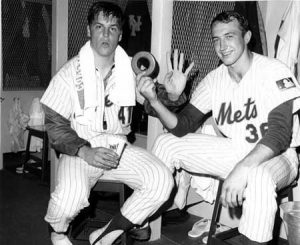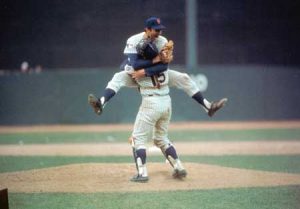Game 8: Miraculous apostasy
New York Mets vs. Baltimore Orioles
Game 5, 1969 World Series
Shea Stadium, Queens, NY
October 16, 1969
As I mentioned earlier, my attention to sports waned in the late high school and college years and that lasted into my mid-twenties. I watched sports with one eye mostly during those years, aware of what was happening (the Giants always coming up short in title games; the Yankees not winning all the time, and soon, not winning at all; the Rangers and Knicks treading water), but not investing much time or emotion in the events.
In 1967, I was married, had an infant son, and was living in New Haven, deeply saddened that the promise of the early 60s was beginning to devolve into the horrors of the late 60s. Sports became a relief from those horrors, and I, not unlike many others I imagine, became a sports fan again to compensate for my disappointment with the world. New Haven, happily, had a TV station in the Red Sox network, and allowed me to see many games in one of the most exciting baseball seasons ever—the three team (Sox, Tigers, Twins) pennant race that was not decided until the final day of the season. While not a Red Sox fan, I got caught up in the excitement—the heroics of Carl Yastrzemski and Jim Lonborg, the tragedy of Tony Conigliaro’s injury, and the agony of another Red Sox World Series defeat.
The other change was that, slowly over the years since they had come into existence in 1962, I had become a Mets fan. Sometime in my college years, in one of those deep navel-gazing sessions that are a hallmark of those years, I came to the psychoanalytic conclusion that I should have been a Dodgers fan in my childhood–that despite the disappointment it entailed, it was a more honest fandom, more real, and it played into my then populist political sentiments, and my long-time emotional attachment to my blue-collar, Dodger fan, paternal grandfather. The Dodgers were, in the local argot, the “People’s Cherce”. I became a baseball apostate. Ron Hunt was my first Mets favorite, and when Tom Seaver and Jerry Koosman arrived, I felt the first glimmering of respectability.

And then, the magical 1969 season happened. Nineteen sixty nine would be my last year as a resident of the New York region (with the exception of a brief 20-month return in the 70s), and I got the sendoff of my dreams with the Mets remarkable season. Considered a so-so back of the pack team, after a slow start they just started improbably winning. And I got to see most of it, including: the Mets win a doubleheader at Forbes Field against the Pirates by identical 1-0 scores, with both the runs driven in by the notoriously weak hitting pitchers, Jerry Koosman and Don Cardwell, on seeing-eye singles just past lunging infielders; Steve Carlton strike out 19 Mets for a new record, but lose the game 4-2 on two two-run homers from Ron Swoboda; Tom Seaver come within two outs of a perfect game against the Cubs. I also got to see them in person once at Shea Stadium—a Saturday afternoon game against the Dodgers, where they won late. And I listened to the famous black cat game (a stray wandered onto the field and made its way to the Cubs dugout) late in the year driving up the Jersey Turnpike (one of the late summer jaunts I was taking between New York and Maryland as part of my relocation).
The Cubs were in first for most of the year, but the Mets slowly and inexorably caught and passed them. The Cubs were a mostly veteran team, and their manager, Leo Durocher, over-worked his starting pitchers, did not rest the regulars enough, and they wilted in what was a brutally hot Chicago summer (they played only day games then—lights were several decades away). Meanwhile, the Mets were getting lights-out starting pitching, superb defense, and just enough offense, led by left fielder, Cleon Jones.

They knocked out the Braves in the playoffs to go up against the best team in baseball, the Baltimore Orioles, in the World Series. They lost the first game, but then took four straight to win the Series. Highlights: the clutch home run of Donn Clendenon and the less expected clutch home run of light-hitting Al Weiss in the clinching game, and in game three, the two absolutely amazing catches by Tommy Agee in center field, and in game four, an even more amazing, diving and sliding catch by Ron Swoboda in right, all of which preserved Mets victories.
Several ironies attended the clinching game five for me. I watched it in Maryland, a scant 35 miles from Baltimore in what would be my new home town, and instead of hearing the rapturous wrap-ups of the New York sportscasters, got to see a Baltimore TV sportscaster report on the game looking like he had just thrown up in his mouth. And, within a few years, I would become an apostate twice over, switching my American League allegiance from the Yankees to the very same Orioles, whose demise I was celebrating (see below).
I remained a Mets fan until the day in 1977 when the Mets GM, M. Donald Grant, a Puritanical grump, in a fit of pique about the salaries star players were getting since free agency had recently begun, traded Tom Seaver to the Reds because of Seaver’s ingratitude in rejecting a low-ball contract extension.
Their 1986 title meant nothing to me, and it matters not if they ever win another one. Like Rick and Ilsa will always have Paris, I will always have 1969, which remains to this day, the happiest season of baseball fandom I have ever known—more happiness in those seven months than in all the championships the Yankees won between 1949-1962.